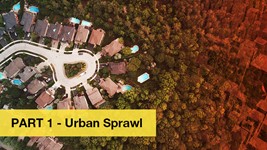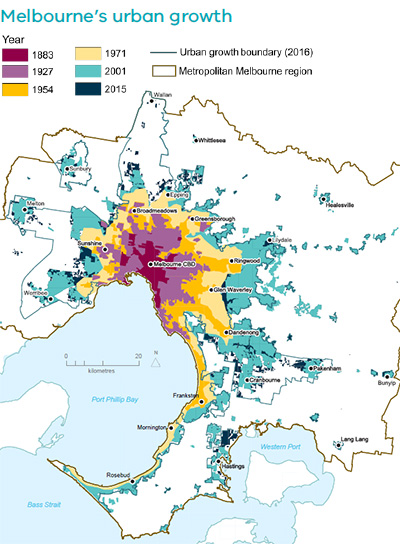Will Australia's cities continue to expand indefinitely?
As Australia’s cities continue to grow outwards, the frictions between urban expansion and the encroachment upon native bushland and the environment have perhaps never been so precariously
As Australia’s cities continue to grow outwards, the frictions between urban expansion and the encroachment upon native bushland and the environment have perhaps never been so precariously balanced.
The pressures of population growth, a lack of housing supply, a rental crisis and property affordability issues all coalesce to fuel demand for new land subdivisions and entire new suburbs on the fringes of Australian cities.
The degree to which this expansion is managed effectively varies, and environmentalists and myriad government reports point out that threatened species are meanwhile losing habitat at a distressing pace.

Part 1 - Urban Sprawl
The seemingly unstoppable expansion of Australian cities, and insight into possible solutions.
Habitat loss and degradation remain the main threats to land-based species in Australia, impacting nearly 70 per cent of threatened species.
According to the State of the Environment Report released this year, of the 7.7 million hectares of land habitat cleared between 2000 and 2017, a staggering 7.1 million hectares (93 per cent) was not referred to the federal government for assessment under the national environment law.
The difficulty in reconciling the often-competing demands on suburban fringe land has only been reinforced by the federal government’s commitment to building a million new homes in the next five years.
Developers and environmentalists are invariably pitted against each other in the debate surrounding urban expansion, or when it’s done poorly, urban sprawl.
But in interviews with API Magazine it was clear both sides were cognisant of the need to limit habitat destruction while addressing critically low housing supply.
Jess Abrahams, National Nature Campaigner with the Australian Conservation Foundation, said urban sprawl was not a fait accompli.
“Urban sprawl is not inevitable; it is a choice.
“Other, more sustainable, options exist, such as Biodiversity Sensitive Urban Design approaches that favour a medium-density, brownfield, infill approach over the low-density, greenfield sprawl,” Mr Abrahams said.
Asked how policymakers and developers could balance the need for continual housing supply with the impact on the natural environment of constant expansion, Mr Abrahams said it came down to planning and prioritising what is important for future generations.
“Government, environmental groups and developers are not working as well together as they need to.
“The bushland on the fringes of Australian cities is absolutely precious habitat for much-loved and vulnerable wildlife.
“In the last year gang-gang cockatoos and koalas – two iconic Australian creatures – have been added to the endangered list, so if we want our kids to experience the thrill of seeing these unique Australian species in the wild, we are going to have to stop knocking over their irreplaceable habitat for new housing estates.
“If we keep allowing our cities to sprawl, it is no exaggeration to say gang-gang cockatoos, koalas and many other species are heading for extinction.
“By shifting the focus from low-density greenfield sprawl to medium density brownfield infill housing it is possible to build new, affordable accommodation in Australian cities and this approach has the added advantage of concentrating the population in areas that are already serviced by public transport, shops, schools and offices,” Mr Abrahams said.
There were, though, examples of effective coordination.
“The Biodiversity Sensitive Urban Design plan for Fisherman’s Bend in Melbourne is probably one example where government, property developers and environmentalists have worked together well,” he said.
Greens and greenfields
Developers argue they are faced with labyrinthine planning processes that limit the prospects of housing supply issues being addressed in the near future.
Damian Collins, Managing Director, Momentum Wealth, said 30 per cent of housing cost is incurred in the planning and greenfield lot title processes that can take developers five years to complete.
“Developers now more than ever have an understand in of environmental issues but to go above and beyond mandated codes incurs a cost on consumers.
“The jury is undecided at this stage as to whether those consumers are willing to pay an 20 or 30 thousand dollars for more sustainable developments and houses,” he said.
Mr Collins said some degree of urban expansion was inevitable.
“It’s unrealistic to think there’ll be no expansion – if consumers demand housing 50 kilometres from the city, developers will deliver it.
Creating more housing within cities through infill development was the ideal solution, Mr Collins said but acknowledged this also presented its own problems.
“If you asked 100 people if they like urban sprawl, 99 would say no, but if you ask 100 people if they want more infill in their own established suburbs, a similar amount will say ‘not in my backyard’,” he said.
“There needs to be a change to the planning framework that will serve the greater good.”
Not going to plan
Even the best laid plans and frameworks are of little consequence if not adhered to.
Maxwell Shifman, National President of the Urban Development Institute of Australia (UDIA), said all of Australia’s major cities have had key planning strategies aimed at increasing densification within existing areas for decades.
“For example, Plan Melbourne has a stated aim of seeing 70 per cent of new dwelling growth in established areas and 30 per cent in greenfield areas.
“But despite these lofty goals, the reality is the complete reverse, and it is only getting more skewed towards new greenfields,” he said.
“The biggest barrier is the substantial cost differential between delivering dense dwellings in established areas and delivering new homes in new greenfield areas.

Source: The State of Victoria Department of Environment, Land, Water and Planning.
“The irony is that governments that have these state planning goals also seem to put into place numerous competing policies that disproportionately impact the viability of delivering denser housing.
“It’s simply not feasible with Australia’s high land costs, substantial planning restrictions and red tape in established areas, together with our high labour and materials costs, to deliver denser housing affordably, at scale.”
In Perth, the world’s longest city, the geography that promotes coastal living north to south is a key reason behind the Western Australian capital’s continual expansion.
Perth’s urban growth has largely followed State Government forward planning over several decades, particularly the Stephenson Hepburn plan of the 1950’s and subsequent corridor plans that have followed similar growth patterns.
UDIA WA CEO Tanya Steinbeck said a balanced approach to urban growth and development, with a need for some greenfield development in conjunction with quality infill development in appropriate areas, was needed.
“Developers deliver greenfield projects within areas that have been earmarked for urban growth and navigate complex planning and environmental approvals to deliver land to the market.
“Buyer demand plays a role in where developers are delivering product to the market.”
Expansion with benefits
Western Sydney had 2.6 million residents in 2021, an increase of 437,000 in 10 years.
Sydney’s urban sprawl extends as far as 60 kilometres to Oran Park, while thousands of homes are planned for Wilton, more than 80 kilometres south-west of the CBD.
Oran Park, an hour southwest of the CBD, was once farmland but will soon be home to more than 25,000 people.
Developing from scratch the fastest growing town in New South Wales is the Greenfields Development Company.
The family company’s General Manager, Mick Owens, said environmental considerations were a key component of the town’s creation.
“From water quality to bio-basins, the town is essentially built upon former grazing land.
“The revegetation and tree canopy is now greater than what was there previously, and issues such as the risk of heat islands have been addressed, and a huge lake will provide community and natural amenity too,” Mr Owens said.
We’d like to see governments stop using developers as political fodder.
- Maxwell Shifman, National President, UDIA
Mr Owens said identifying growth areas that can improve rather than decimate the land was the key to delivering new housing supply while having minimal impact on the environment.
“Growth centre areas need to be identified so that threatened species are conserved, biodiversity offsets are in place – it’s about being clever about where and how you expand.”
Whether that was likely to happen remained unclear.
“The NSW planning system is so complex, many are left wondering how anything gets approved at all,” Mr Owens said.
“Convoluted zoning and development approval processes are the biggest hindrance to quality development (of the outer suburban fringes) in a New South Wales context,” he said.
Risk and reward
Sarah Bekessy, who has been teaching in Sustainability and Urban Planning at RMIT University since 2004, said ecosystems on the edge of our cities have high ecological value.
“There are three times as many threatened species on the edges of our suburbs compared to rural areas, so they are disproportionately important areas,” Professor Bekessy said.
She identified the areas of Sydney, Melbourne and Brisbane most at risk.
“There’s less than 1 per cent of the Victorian Volcanic Plains grasslands left, Sydney’s biodiverse Cumberland Plains Woodland is disappearing and in Greater Brisbane, 98 per cent of vegetation is threatened and expansion there just continues unabated.”
The Victorian Volcanic Plains is a widespread area of natural temperate grasslands which stretch from Melbourne to the South Australian border and cover an area of 22,000 square kilometres. The plains are home to eight nationally threatened animal species.
The Cumberland Plain Woodland, or Western Sydney Woodland, is a grassy woodland community found predominantly in Western Sydney, that comprises an open tree canopy, a groundcover with grasses and herbs, usually with layers of shrubs and small trees.
Currently, less than 6 per cent of the Woodlands remain in small parts distributed across the western suburbs of Sydney, totalling only around 6400 hectares. Cumberland Plain Woodland was listed as an Endangered Ecological Community under the Threatened Species Conservation Act 1995. The greatest threats to the Cumberland Plain Woodland include land clearing for agriculture and urban sprawl.
“The way Australia handles high density living needs to be rethought in Australia, as knocking down quarter acre blocks and replacing with two big concrete houses is not sustainable, nor does it create very liveable spaces in our suburbs," Professor Bekessy said, citing Barcelona and Berlin as cities that created courtyarded, liveable high density apartments and developments.
Dr James Fitzsimons, Director of Conservation and Science at The Nature Conservancy Australia, told API Magazine that urban sprawl does not have to be inevitable.
“Melbourne, for example, has set an urban growth area boundary designed to limit urban sprawl.
“If cities are going to continue to increase in population size, and sprawl curtailed, then well considered and designed densification of some parts of cities is essential.
“It is important that in the densification process that green space and urban canopy is maintained or replaced, on both public and private land.”
Dr Fitzsimons said urban forests have multiple benefits from reduction in heat, increased aesthetics and health benefits and as habitat.
“Many densification projects have not adequately accommodated this critical element of urban infrastructure and better coordination between policy makers, planners, urban ecologists and developers is needed to ensure our cities remaining liveable with increasing temperatures cities will face into the future,” he said.
UDIA’s Mr Shifman agreed there needed to be more collaboration and less politicising of issues around urban expansion.
“A lot of what is said by environmental groups is based in academic theory and not based in reality; we would welcome better dialogue on what the sector delivers, particularly from a relative affordability perspective.
“We’d also like to see governments stop using developers as political fodder and instead treat us like the key partners and contributors we are.
“We can all work together much better to discuss the positives and challenges associated with all forms of development, including that in new greenfields areas.”



















